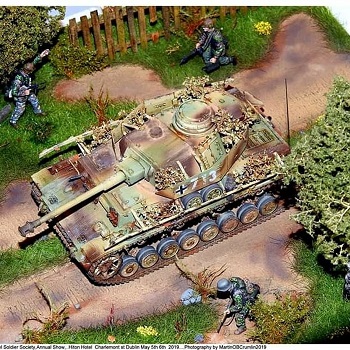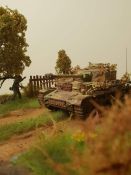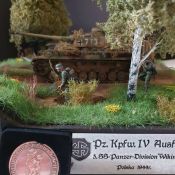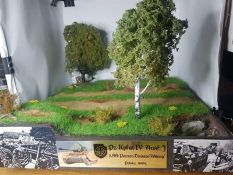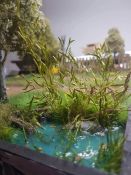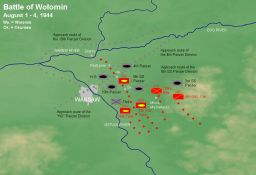|
Marcin Ciesielski |
English: The base is made of polystyrene. I made grass myself using an electric machine and wikol glue. Ffence made of ice-cream sticks. Pz.kpfw IV J Tamiya 1/35, Dragon figures 1/35. The medal was won at a model show in Dublin.
After the Soviet reconnaissance units reached Warsaw in late July, on 1 August 1944 the Warsaw Uprising started. Starting from an area south of Mińsk Mazowiecki, Major General Nikolai Vedeneev's 3rd Tank Corps (part of the Soviet 2nd Tank Army) thrust northwest through Okuniew and Wołomin to Radzymin, reaching an area only three miles (five kilometers) from the strategic bridge over the Narew River at Zegrze.
In response to Vedeneev's thrust, the Germans started a tactical counter-attack near Radzymin on 31 July. The offensive, carried out by 4 understrength Panzer divisions,[2] was to secure the eastern approaches to Warsaw and Vistula crossings, and aimed to destroy the three tank corps of the Second Tank Army in detail. Under the leadership of German Field Marshal Model, the 4th, 19th, Hermann Göring, and 5th SS Panzer Divisions were concentrated from different areas with their arrival in the area of Wołomin occurring between 31 July and 1 August 1944. Although the 3rd Tank Corps gamely defended the initial assaults of the Hermann Göring and 19th Panzer Divisions, the arrival of the 4th Panzer and 5th SS Panzer Divisions spelled doom for the isolated and outnumbered unit.[3]
Already on 1 August, the leading elements of the 19th and 5th SS Panzer Divisions, closing from the west and east respectively, met at Okuniew, cutting the 3rd Tank Corps off from the other units of the Second Tank Army. Pressed into the area of Wołomin, the 3rd Tank Corps was pocketed and destroyed on 3 August 1944. Attempts to reach the doomed tank corps by the 8th Guards Tank Corps and the 16th Tank Corps failed, with the 8th Guards Tank Corps taking serious losses in the attempt. Although Model had planned to attack the 8th Guards Tank Corps next, the withdrawal of the 19th and Hermann Göring Panzer Divisions to shore up the German defenses around the Magnuszew bridgehead forced the remaining German forces around Okuniew to go on the defensive.[4][5]
For unknown reasons, on 2 August 1944 all armies that were to assault Warsaw had their orders changed. The 28th, 47th and 65th Armies were ordered to turn northwards and seize the undefended town of Wyszków and the Liwiec river line. The 2nd Tank Army was left in place and had to fight the Germans alone, without support of the infantry. Also, 69th Army was ordered to stop while the 8th Guards Army under Vasily Chuikov was ordered to halt the assault and await a German attack from the direction of Garwolin.
Further combat lasted until 10 August, when the Germans finally withdrew. Soviet losses were heavy, but not heavy enough to affect the overall course of their thrust to the vicinity of Warsaw. The 3rd Tank Corps was destroyed, the 8th Guards Tank Corps took heavy losses, and the 16th Tank Corps took significant losses as well. Overall, the Second Tank Army's losses were significant enough that it was withdrawn from the front lines by 5 August 1944.
Deutsch: Die Basis besteht aus Polystyrol. Ich habe selbst Gras mit einer elektrischen Maschine und Wikol-Kleber gemacht. Zaun aus Eisstielen. Pz.Kpfw IV J Tamiya 1/35, Figuren Dragon 1/35. Die Medaille wurde bei einer Modellausstellung in Dublin gewonnen.
(Google Übersetzer) Nachdem die sowjetischen Aufklärungseinheiten Ende Juli Warschau erreicht hatten, begann am 1. August 1944 der Warschauer Aufstand. Ausgehend von einem Gebiet südlich von Mińsk Mazowiecki stieß das 3. Panzerkorps von Generalmajor Nikolai Vedeneev (Teil der sowjetischen 2. Panzerarmee) nordwestlich durch Okuniew und Wołomin nach Radzymin vor und erreichte ein Gebiet, das nur fünf Kilometer von der strategischen Brücke über die Narew River bei Zegrze.
Als Reaktion auf Vedeneevs Vorstoß starteten die Deutschen am 31. Juli einen taktischen Gegenangriff in der Nähe von Radzymin. Die Offensive, die von 4 Panzerdivisionen mit geringer Stärke durchgeführt wurde [2], sollte die östlichen Annäherungen an die Warschauer und Weichselkreuzungen sichern und darauf abzielen, die drei Panzerkorps der Zweiten Panzerarmee im Detail zu zerstören. Unter der Führung des deutschen Feldmarschallmodells konzentrierten sich die 4., 19., Hermann Göring und 5. SS-Panzerdivision aus verschiedenen Gebieten, wobei ihre Ankunft in der Gegend von Wołomin zwischen dem 31. Juli und dem 1. August 1944 erfolgte. Obwohl das 3. Panzerkorps spielerisch war verteidigte die ersten Angriffe der Divisionen Hermann Göring und 19. Panzer, die Ankunft der 4. Panzerdivision und der 5. SS-Panzerdivision bedeutete das Schicksal der isolierten und zahlenmäßig unterlegenen Einheit. [3]
Bereits am 1. August trafen sich in Okuniew die führenden Elemente der 19. und 5. SS-Panzerdivision, die sich von Westen und Osten schlossen, und trennten das 3. Panzerkorps von den anderen Einheiten der Zweiten Panzerarmee. In das Gebiet von Wołomin gedrängt, wurde das 3. Panzerkorps am 3. August 1944 in die Tasche gesteckt und zerstört. Versuche, das zum Scheitern verurteilte Panzerkorps durch das Panzerkorps der 8. Garde und das 16. Panzerkorps zu erreichen, scheiterten, wobei das Panzerkorps der 8. Garde schwere Verluste hinnehmen musste der Versuch. Obwohl Model geplant hatte, als nächstes das Panzerkorps der 8. Garde anzugreifen, zwang der Rückzug der 19. und der Hermann Göring Panzerdivision zur Stützung der deutschen Verteidigung um den Magnuszew-Brückenkopf die verbleibenden deutschen Streitkräfte um Okuniew in die Defensive. [4] [ 5]
Aus unbekannten Gründen wurde am 2. August 1944 der Befehl aller Armeen, die Warschau angreifen sollten, geändert. Die 28., 47. und 65. Armee wurde angewiesen, sich nach Norden zu wenden und die nicht verteidigte Stadt Wyszków und die Liwiec-Flusslinie zu erobern. Die 2. Panzerarmee blieb an Ort und Stelle und musste ohne Unterstützung der Infanterie allein gegen die Deutschen kämpfen. Außerdem wurde der 69. Armee befohlen, anzuhalten, während der 8. Garde-Armee unter Wassili Tschuikow befohlen wurde, den Angriff zu stoppen und auf einen deutschen Angriff aus Richtung Garwolin zu warten.
Der weitere Kampf dauerte bis zum 10. August, als sich die Deutschen endgültig zurückzogen. Die sowjetischen Verluste waren hoch, aber nicht schwer genug, um den gesamten Verlauf ihres Vorstoßes in die Nähe von Warschau zu beeinflussen. Das 3. Panzerkorps wurde zerstört, das 8. Panzerkorps der Garde erlitt schwere Verluste und das 16. Panzerkorps erlitt ebenfalls erhebliche Verluste. Insgesamt waren die Verluste der Zweiten Panzerarmee so hoch, dass sie bis zum 5. August 1944 von der Front zurückgezogen wurden.
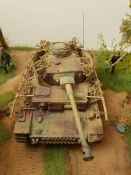 |
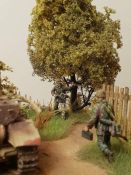 |
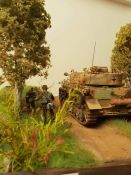 |
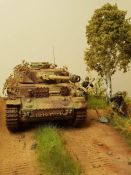 |
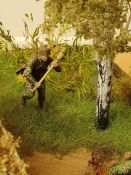 |
|
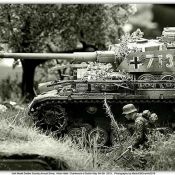 |
|
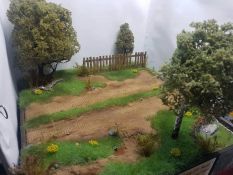 |
|
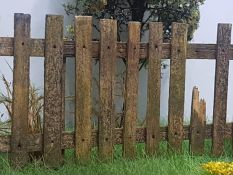 |
|
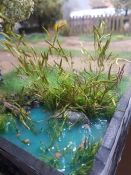 |
© 08/2020 Marcin Ciesielski
